Planting melons in open ground or in a greenhouse: terms, rules of care and cultivation
If you came across this article, then this can only mean one thing - you are on fire with the idea of making melon in your country house and growing a southern beauty melon.
How to do this correctly if you want to sow melon seeds directly into open ground or a greenhouse, read further in this article.
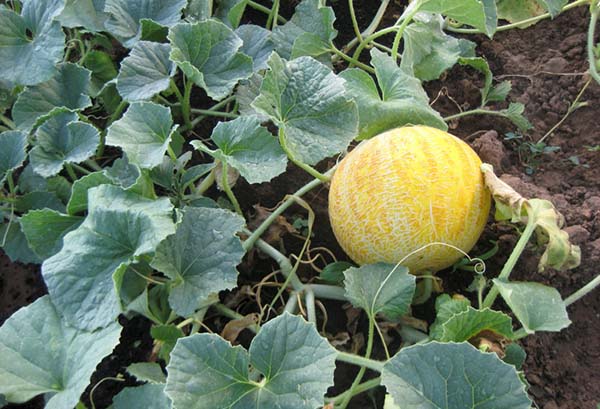
Content
- 1 How to Pick a Good Melon Variety
- 2 When to plant melons outdoors or in a greenhouse
- 3 Choosing a place for melons: in what soil to plant melons
- 4 How to plant melon seeds outdoors or in a greenhouse
- 5 How to care for melons outdoors and in a greenhouse: growing rules
- 6 Diseases and pests of melons
- 7 When to harvest melons and how to store them
How to Pick a Good Melon Variety
The key to success in growing melons is the correct choice of a variety suitable for the climatic zone of your place of residence (in other words, the variety must be zoned). Let's say in regions with cool summers ideally stay at early varieties and hybrids melons with a ripening period of about 65-85 days. In this case, the most recommended varieties are Titovka, Roksolana, Ambrosia, Ignacio, Assol, Altai, Scythian gold, Delano, other.
For greenhouses super early ripening melons such as Altai, Titovka (ripening period is just over 55-65 days).

If you are satisfied with medium-sized sizes, then you can plant early-maturing varieties: Collective farmer, Fairy tale, Blondie, Cappuccino,and etc.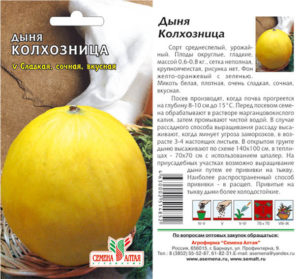
If you decide to grow melon with medium ripening, then know that you have to wait within 2.5 months (85-95 days).
Most requested mid-season varieties among enthusiastic summer residents are recognized Don Quixote, Primal, Anzer, North Star, Anna Max, Jumbo, Chogare (Bukhara), Assate, Sunny delicacy, Luna, Torpedo.

However, one should not underestimate and late varieties... Among them, the most popular are Princess Mary, Powdered Sugar, Emerald, Walking.
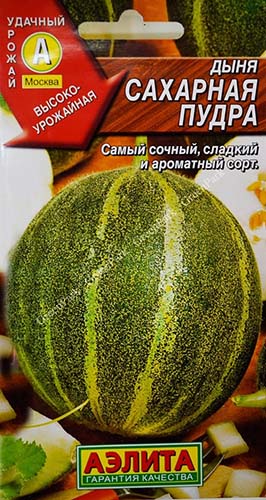
And also (taking into account geography) the following cultural (table) varieties of melons are excellent for growing: Kassaba, Walking, Pineapple, Torpedo (all representatives of Central Asian varieties), Collective farmer, Cantaloupe, Ethiopian, Banana, Armenian cucumber(all European varieties), Vietnamese, Melotria rough or mouse, Horned (all exotic varieties).
When to plant melons outdoors or in a greenhouse
When choosing the timing of planting melons in the ground, you must pay attention to the following circumstances:
- climatic features of the growing region (when the soil warms up to + 12-15 degrees, and the night temperature ceases to fall below + 15-16 degrees);
The main thing is not to rush, the procedure is carried out with the onset of stable heat.
- the place or conditions for further cultivation (you can plant it in the greenhouse 7-14 days earlier, in the open ground - later).
But besides this, some gardeners pay attention to favorable dates for sowing melon seeds according to the lunar calendar.
Depending on the region and climate
Only in the southern regions, melons, as a rule, are planted by seeds directly into open ground.
In colder regions melons are grown through seedlings.
However, if you warm up the garden in advance or plant it in a greenhouse, then you may well be able to count on success.
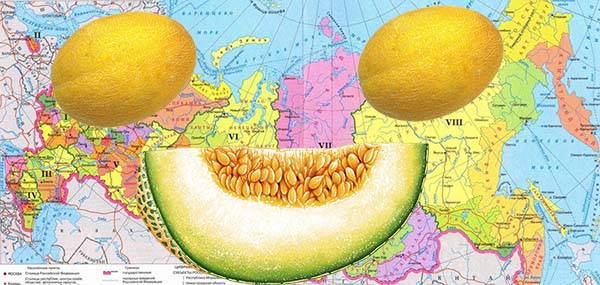
Thus, on South of Russia melon seeds are planted in the ground at the end of April-beginning of May, in Middle lane - late May-early June. At the same time, melons are planted at Urals and Siberia.
Actually, melons are planted at a similar time and in the North-West (in the Leningrad region).
According to the lunar calendar in 2020
Favorable The dates for sowing melons in open ground or a greenhouse, according to the lunar calendar, in 2020 are the following days:
- in April - 1, 2, 24, 25, 27-30;
- in May - 2-4, 6, 15-17, 20, 21 25-31;
- in June - 2-4, 11-14.

However, the summer resident does not always have the opportunity to sow on the specified dates (in the spring, not only melons are planted), therefore it is important to know when it is strictly forbidden to sow (the days of the Full Moon and New Moon, as well as the period when the Moon is in Aquarius, because . is a barren and dry sign -italicized), and these dates must be taken into account in your spring calendar.
In this way, unfavorable days for planting melons in 2020 are the following numbers:
- in April - 8,15-17, 23;
- in May - 7,13-14, 22;
- in June - 5,9-11, 21.
According to the lunar calendar, from the magazine "1000 Tips for Summer Residents".
Choosing a place for melons: in what soil to plant melons
When you choose a place in the garden for melon, then you should definitely stop on the sunniest site at your summer cottage, which is well protected from the winds.
In partial shade, or even more so in the shade, you will not grow any melons!
On one melon (in a greenhouse or open field) you can successfully grow and watermelons and melons... They are not pollinated.
Then plant: crop rotation rules
It is very important to consider what was growing in the garden in the previous season.
So, it is not recommended to sow melons in the place where pumpkin seeds were previously grown (pumpkins, zucchini, squash, watermelons and melons themselves).
The fact is that crops have similar diseases, and they suck out similar macro- and microelements from the soil.
It's another matter if you thoroughly process (disinfect) and fertilize the beds.
It is ideal to plant melons in a garden where the following crops were previously grown and harvested (mown): cereals, legumes, various greens (lettuce, spinach), tomatoes, early potatoes, as well as cabbage, onions or garlic.

The soil
Best suited for growing melons (like watermelons) sandy and sandy loam the soil... In other words, it should be very loose and naturally fertile.
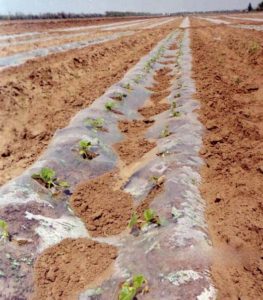
However! If you have exceptionally sandy soil, then experienced melon growers still recommend adding a little clay to the planting holes, because it also contains its own trace elements, moreover, it is a good holder of moisture.
In other words, light loam and sandy loam chernozems are also suitable.
Preparing the garden
Of course, most gardeners know that a garden bed for planting melons (and for any other crops) should be tidied up in the fall. To do this, you need to dig up the soil on a shovel bayonet (or even better by one and a half) and add organic matter (rotted manure or humus), as well as mineral fertilizers (potassium sulfate, superphosphate - all according to the instructions, somewhere around 20-40 grams per square meter).
Important! If you have enough heavy and clayey soil (loam), then it is advisable to also make a digging sand.
It is possible to prepare a garden bed or a hole (dig holes 30 to 30) in the spring, just before planting, but it is better at least a month or a couple of weeks.
Advice! In the Central lane (Moscow region), in the Urals and Siberia, it is advisable to grow melons in high beds (originally in tunnel greenhouses) or in greenhousessince for melons, the most important thing is that the roots are always warm.
So, in the spring you can spill your beds or planting holes with a solution of Baikal EM-1, and then add wood ash (100-200 grams per square meter). Or, for digging, add a complex mineral fertilizer to nitroammofosk (according to the instructions, somewhere around 30-40 grams per 1 square meter).
Important! After you prepare the bed, 10-14 days before planting seedlings or planting seeds, it should cover with foil (or white non-woven) and put a mini-greenhouse on top on arcs... During this time, the earth will warm up as deeply as possible.
It will be even better if before you lay hay or dried grass in the planting holes, and then again sprinkle with earth from the dug hole. Due to the decomposition of hay, additional heat will be generated.
Video: preparing the beds for planting melons and watermelons
How to plant melon seeds outdoors or in a greenhouse
Well, after you have decided on a place to grow your melons and made a garden, it is time to prepare the seeds themselves, as well as to properly plant them.
Preparing and processing melon seeds before planting seedlings
In order not to ruin the planting from the very beginning, it is required to initially properly prepare the melon seeds.
Advice! If you harvested seeds yourself, then 2-3 years old seeds are optimal for sowing. It is these specimens that have the highest germination percentage.
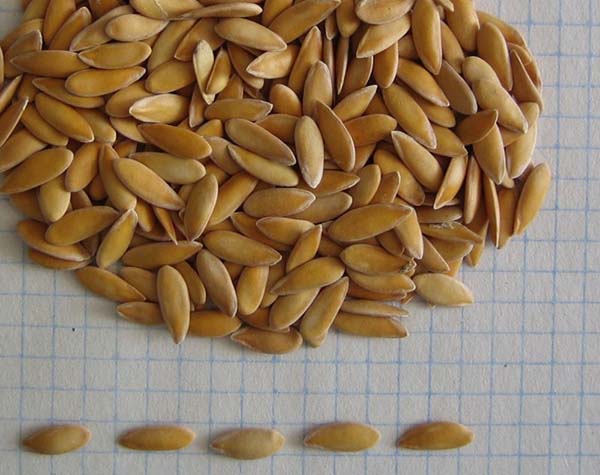
Recognize the suitability of seeds in a few minutes it is possible by immersing them in a 3-5% solution of table salt (at the rate of 3-5 g of salt per 100 ml of water). Weak and weightless (in other words, empty and unviable) will quickly float to the surface, they need to be selected, and sank to the bottom - process further.
Then you can stimulate your planting material (this will have a beneficial effect on the formation of female flowers - future fruits).For this, melon seeds are recommended warm up for 20-30 minutes in hot water (50-60 degrees).
Then it would be nice to immerse them for 20-30 minutes in a 1% solution of potassium permanganate for disinfection, or even better in solution Fitosporin (according to instructions)... At the end of the time, rinse them under clean water and dry until the required flowability appears.
And the most effective pre-planting procedure is considered soaking and germinating seeds.
Summer residents from cold regions will be primarily useful to spend hardening planting material of thermophilic melon. To do this, you need to wrap the seeds in damp gauze and refrigerate for 10-12 hours. After that, take them out and put them in heat for 10-12 hours. This should be done within 3-4 days, in other words, it is necessary to expose the seeds to temperature changes (stress), and then germinate.
Soak seeds can be in Epin or Zircon. Also, as an option, you can prepare an infusion solution wood ash (5 grams per 250 ml of water) and leave in it overnight (10-12 hours). In addition, you can use the most common hydrogen peroxide (1 tsp. 3% peroxide in 0.2 separated or filtered water).
Better not just soak, but germinate the seeds in one of the above growth stimulants.
To germinate seeds, they need to be wrapped in wet gauze (or cotton pads), put on a plastic bag or put in a container with a lid. Then they should be removed to the warmest place in the apartment, where the temperature is + 22-28 degrees. After 3-7 days, they should hatch (the higher the temperature, the faster this will happen).
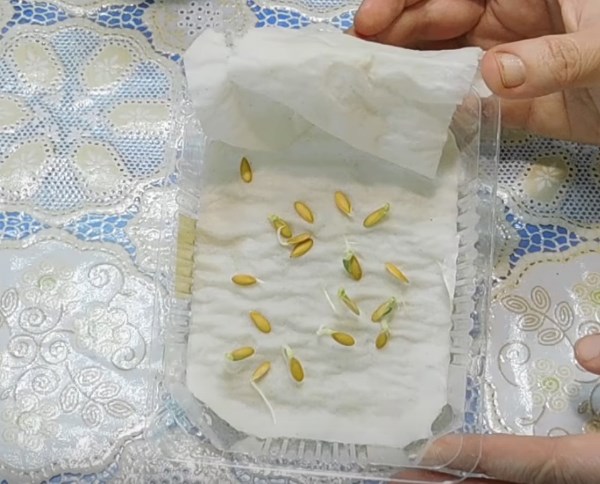
Video: soaking and germinating melon seeds in two ways
By the way! The method of germinating melon seeds also shows positive results. in wet sand or wet sawdust. Alternatively, for a change, you can use hydrogel... Naturally, the temperature should be appropriate (+22 .. + 28 degrees).
And you can also act like the blogger from the following video: put the seeds in the freezer for 20 minutes, having previously laid them on the coconut substrate, and then put them in a warm place for further germination.
Important! If you purchased pelleted (processed) seeds, then they do not need any pre-sowing preparation, they should be sown dry.
However, if desired, they can be germinated (in order to achieve the fastest germination).

Direct planting of seeds
Step-by-step instructions for planting melon seeds in the ground (open or closed):
- Make planting holes or rows (grooves).
The melon planting depth is 2-3 cm (although some sources recommend up to 4 cm).
- Moisten the wells or grooves slightly with warm water.
- Lay out the seeds according to the recommended planting pattern (for example, 70 x 70 cm).
Advice! If you do not have a deficit of seeds, then it is better to put 2-3 seeds in each hole or at a closer distance if you plant in grooves. And after germination, remove weaker plants.
- Cover the holes with earth or level the grooves.
- Do light watering again with warm water.
- Cover with foil or non-woven fabric.
Video: planting melons in open ground
Transplanting
If you want to guaranteed to get a decent harvest of melons in a region with a short summer, then it is advisable to pre-grow seedlings and only then plant them in open ground (under a temporary greenhouse) or a greenhouse by transshipment.
Note! The site already has detailed material about planting and growing melon seedlings at home.
Video: growing melon through seedlings
Planting on black or white agrofibre
Many gardeners from the northern regions prefer to grow melons under a black film, or rather under a black nonwoven material (spunbond or lutrasil), covering their melons with it.
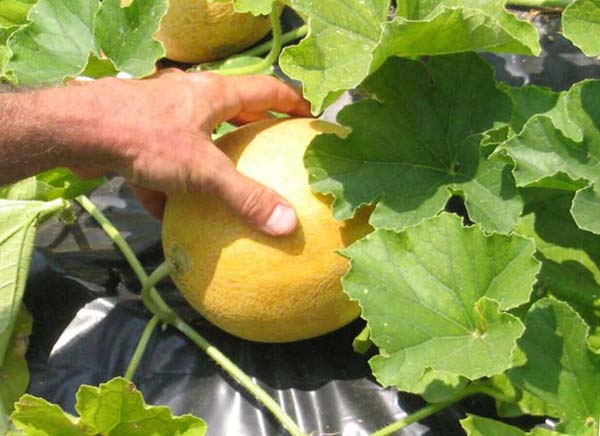
Note! However, there is also the opposite opinion. According to him, transparent film will be much more effective, becauseunder it, the earth will warm up even better (after all, black heats up more by itself than the soil).
As for the procedure itself, first prepare the garden bed and dig holes. Then cover with agrofibre, cut small cross-shaped holes into which you plant seedlings later, or plant seeds (with direct sowing into the ground). And on top you can also put a greenhouse on arcs.
By the way! In a similar way, they are very often grown strawberries.
How to care for melons outdoors and in a greenhouse: growing rules
In order to grow sweet melons, they must be properly cared for. Next, let's talk about the main aspects and agronomic techniques that will help you get a decent harvest even in a short summer.
Note! Melon care in the greenhouse in principle, it does not differ much from growing in open ground, except that you need to water less often and be sure to tie it up, and also pollinate. In addition, you should regularly ventilate in very hot and sunny weather, when the air temperature rises above +30 degrees. These are, perhaps, the main nuances of growing any crops in greenhouse conditions.
Shelter
If in your region the difference between night and day temperatures is significant enough, it rains, then at the first time after planting seedlings or emergence of seedlings, you should make a temporary "shelter" in the form of a mini-greenhouse on arcs. Any white nonwoven material (the same lutrasil or spunbond) or film is suitable for this.
Note! This is also done to protect plants from birds (crows), which can steal not only the seeds from you, but the plants themselves.
With an increase in temperature, when the summer heat begins (in July), the greenhouse can be completely removed (the film, for sure, but in case of unbearable heat and the scorching sun, the non-fabric can be left).
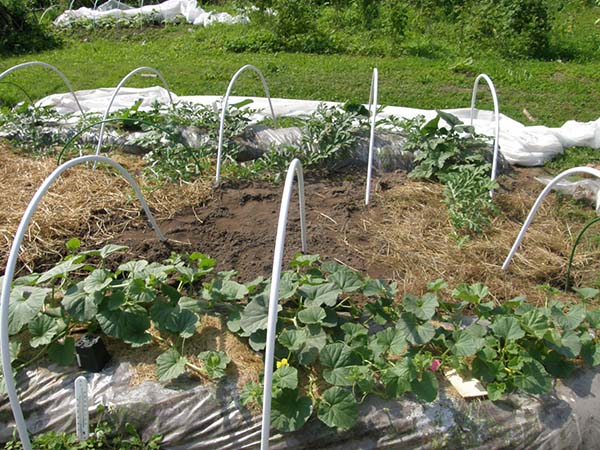
Mulching
Many advise, after planting seedlings or emergence of seedlings, to mulch the soil in the near-trunk circle. However, it is still not worth doing so early, since the earth will not be warmed up enough by the sun, and the melon, or rather its roots, will slowly develop.
Mulch should cover the ground around the plant only when the heat comes, and it grows a little (there will be 2-3 true leaves).

Watering
Melons should be watered infrequently, but abundantly. And it is strictly necessary warm and settled water.
As a rule, melons are watered about once a week before fruit set and once every 10-14 days after, depending on the climate.
It is especially important to water the melon during the period of fruit growth, namely from the moment when the fruit is the size of a tennis ball (i.e. after pollination).
Note! Melon (like all melons) should be watered not only at the root, but also around (i.e. the entire garden). It's not just that we plant seeds at such a distance.
And when the fruits stop growing in size, watering should be stopped (i.e., about 10-15 days before harvesting), so that the melons lie down calmly and collect sugar (become tasty and sweet).
Top dressing
At the initial stages of melon development, it should be fed nitrogen fertilizers.
But only at the beginning of active growth and development of seedlings (in the first month after germination, every 10-14 days), otherwise, due to nitrogen overfeeding, it will begin to fatten, increase the green mass, and there will be fewer ovaries.
For example, organic fertilizers such as chicken manure or mullein, as well as herbal infusion (green fertilizer) are suitable for this. Or mineral fertilizers - ammonium nitrate and urea (carbamide).
Worth knowing! Ammonium nitrate is absorbed by the plant faster than urea (urea).
It is well known that all melons are very love potassium (thanks to him they gain sugar), therefore, it is recommended to feed the melon with the following fertilizers (every 10-14 days, it is necessary to finish it along with watering when the fruits stop growing):
- If you are an organic follower, then your choice is wood ash (1-2 glasses of ash in a bucket of water, let it brew for a day).
Advice! Or you can just sprinkle the ash over the garden and water it.
- Or you can purchase a ready-made potash mineral fertilizer, for example, the same potassium sulfate (potassium sulfate).
By the way! Your melon will definitely love a compound fertilizer like Potassium humate, which also contains many necessary trace elements... However, Potassium Humate is not really a potassium fertilizer.
In general, now on sale you can find special fertilizers for melons.
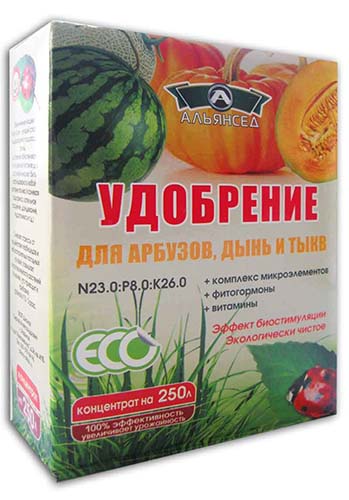
Of course, the question of feeding is quite difficult, since it is better to underfeed the plants than overfeed. But it so happens that some plants on one piece of land grow quickly and confidently, while the rest turn pale and bend. This clearly indicates inadequate plant nutrition. Therefore, it's up to you to decide.
We almost forgot! Phosphorus melons are also required, albeit not in the same amount as potassium. Therefore, it is still necessary to give phosphorus feeding once during the beginning of the growing season. However, if you have correctly prepared the garden in advance and have already entered into it superphosphate, then you can do it.
Worth knowing! The presence of phosphorus has a direct effect on nitrogen availability!
Open field and greenhouse formation: when and how to pinch
Pinch the central stem over 3-6 real leaves, so that the plant begins to branch better and releases side shoots of the first order (respectively 3-6, since they will go from the axils of the remaining leaves, like in tomatoes), on which they are mainly formed female flowers = your harvest.
Important! Watermelons are shaped in a completely different way. they bear fruit mainly on the main stem.
And after on the lateral shoots, after pollination, fruits the size of a walnut are formed (including on shoots of the 2nd order), their tops will also need to be pinched after 5-6 leaves (after the fruit).
Depending on the large-fruited and early maturity, 2-4 of the strongest whips of the first order and several of the second are preserved on one plant (some varieties bear fruit on them). In this case, only 1-2 fruits are left on 1 shoot, i.e. only about 2-8 melons, in other words, the excess fruits should be removed on their own (rationing the harvest).
If you do nothing, then the plant will spend extra energy on shoots and pouring an excessive amount of fruits, which eventually will not have time to ripen.

Video: forming melons in a greenhouse
Pollination
It happens that due to a number of reasons (cloudy weather, no pollinating insects), although the melon blooms, the development of ovaries is not observed on it (the flower and ovary dry up and then disappear), especially when it comes to greenhouse cultivation ... In such cases, it is necessary to carry out pollination with your own hands, touching the female pistil with the stamens of the male flower (which must be plucked) (they can be easily distinguished by the presence of small melons at the base).
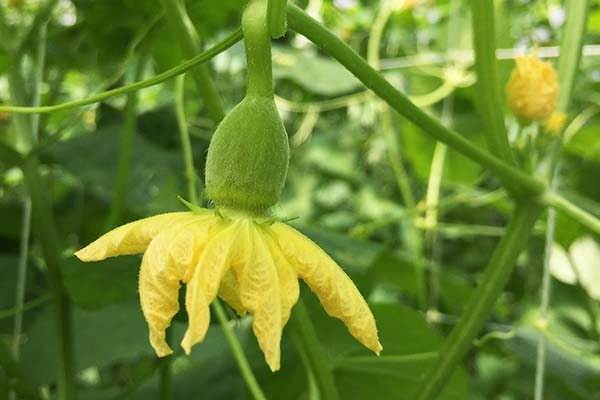
By the way! It will be possible to understand that pollination was successful after 3-5 days, when the fruit begins to noticeably increase in size.
In addition, in such a situation, it is good to use specialized preparations such as "Ovary" or "Bud".
Video: pollination of melons in a greenhouse
Garter and hanging
Melon shoots themselves cannot curl (like cucumbers), so they are required on their own tie to trellises... This will set the direction of their growth.
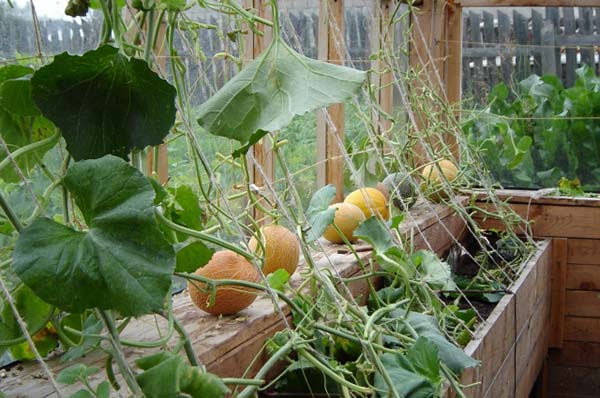
When the melons (fruits) themselves are large enough, they should hang in nets, and put the lower ones on something. Otherwise, the fruit may simply break off.

Concerning the cultivation of melons in open ground or in growing (i.e. without tying - right on the ground), then, when the fruits start to grow and ripen, they must not be allowed to rot while on wet ground after watering. In this case it is worth put wooden planks under them.
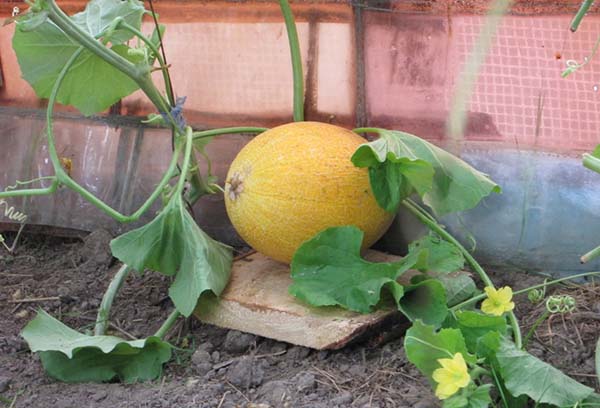
Video: watering, feeding and normalizing fruits on a melon
Diseases and pests of melons
Melons, as a representative of pumpkin (melon) crops, are attacked by similar diseases (powdery mildew, anthracnose, fusarium) and pests (melon aphids, spider mites), as well as cucumbers.
It is better to do prevention than to cure later.
To prevent pests, planting melons for the purpose of prevention is recommended to be treated with special insecticidal biological products, for example, Fitoverm, Bitoxibacillin, Aktofit.
If the attack is serious, in this case you will have to use chemical insecticides: Aktara, Akarin, Decis Profi, Fufanon, Tanrek.
If you are a supporter of simple but popular folk remedies, then against pests you can use mixture wood ash and tobacco dust dusting her beds.
Concerning melon diseases, then as a prevention again, it is recommended to take biological drugs, the same Fitosporin (according to instructions, as for cucumbers) or Trichodermin (Trichoderma Verde).
Of course, if the disease spreads strongly, then chemical fungicides will have to be fought.
When to harvest melons and how to store them
The ripeness of the melon, and therefore the moment that it is time to harvest, can be easily determined by the color of the peel and the aroma of the fruit. You can also press on the fruit from the side where there is no stalk - a ripe melon will have it slightly soft (if it is very soft, then the fruit is overripe, if it is hard, it is not ripe).
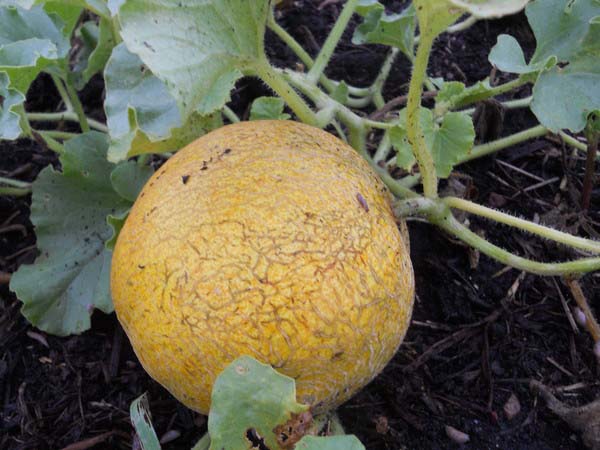
Advice! Pull it, and if it is ripe, it will come off by itself, because the tail is already dry.
Video: when to pluck a melon
By the way! About, how to choose sweet and ripe melon, detailed in this material.
As for their further storage, it should be taken into account that, as a rule, it will not be possible to preserve early melons for a long time. Even if they are not ripe, they will not ripen indoors. As for the melons of the average ripening period, they may well ripen after being removed from the bush, since they can be stored for some time (just over a month).
Melon is, perhaps, the most refined melon culture in taste. So it doesn't matter if there is still a lot of trouble ahead at the summer cottage, you will receive more than a decent reward. The lot of a novice summer resident is to destroy the illusion about the impossibility of growing melons on their 6 acres. Our recommendations and advice will help him in this. After all, the main secret of success is in the rational choice of the variety and the use of the correct agricultural technology.
Video: planting melons in a greenhouse and open ground

